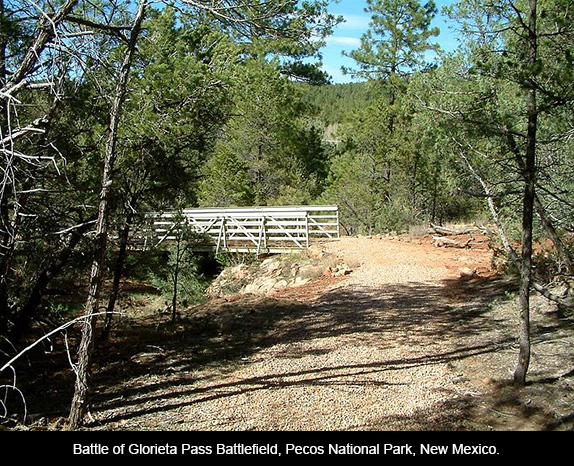
Most of us don’t think about the American Civil War being fought in New Mexico, but this past February 21 marked 153 years since of the Battle of Valverde. Below Peralta, a short throw from Hwy 380, not far from the Owl Bar, there is an area on the Rio Grande called North Ford. It is also called Valverde—“green valley”—a rather picturesque name that does not quite tell the true story of this bloody bend of river.
Valverde was the first engagement in New Mexico between the forces of the Confederacy and the Union in what was then called the War of the Rebellion.
General Sibley had convinced Jefferson Davis that by sending him to subdue New Mexico, the way would be open to the Colorado gold fields, and then they would push on to California to secure deep water ports. They did not count on the Colorado Volunteers who raced into New Mexico territory to put a stop to the rebels’ advance.
Colorado Governor Gilpin feared the Rebel army would march into Denver. He also knew Washington wasn’t concerned. Gilpin convinced Captain Cook to raise a troop of volunteers.
A prominent, and imposing, Denver preacher named John Chivington told the governor, “If there’s fighting to be done, I want to fight.” Chivington would become one of the heroes in this war. He was a staunch abolitionist.
Gilpin was panicky and began printing his own federal money, and he bankrolled the army with the bogus federal treasury notes; but when the notes got back to Washington, Gilpin was removed from office. The money was deemed worthless and he was nearly lynched by the soldiers.
Chivington quieted the men by telling them that if they were in the army only for money, they had joined for the wrong reasons anyway. Then to finish it off, the Major preached a sermon, the one about duty and good versus evil and the American family.
A few months later these troops would fight and die in a battle that would decide the future of the Territory of New Mexico, and we can pay tribute to Governor Gilpin, and those brave men, who raced to our aid, for without them New Mexico would have most certainly fallen under the Stars and Bars.
When Captain Henry Seldon and his Colorado Volunteers joined up with Kit Carson’s First New Mexico Volunteers and met General Sibley’s Rebel army in mid-Rio Grande, the hand-to-hand fighting caused the great river to run red with blood.
The rebels called them “the devils from Pike’s Peak” as they didn’t break under fire, as the 2nd New Mexico Volunteers had broken and ran at the sight of the approaching Texans—who charged into battle with war whoops and screams, wielding shotguns and pistols, Bowie knives and swords.
Although Sibley had retired in an alcoholic stupor, the Texans had won, technically; the Union forces retreated to Ft. Craig. For the Texans it was a Pyrrhic victory because of the 200 dead and wounded.
Sibley’s army regrouped and headed north toward Albuquerque, which they occupied on March 2, 1862. Twenty-four days later at Glorieta Pass, the 1st Colorado surprised the Texans and after a 3-hour battle they fled for their lives. One of the Texans said that the Coloradans who “charged us seemed to have charmed lives.”
But when 400 of the brave Coloradans and a few of the New Mexico Volunteers, under Major Chivington, got lost and wound up stumbling on the Confederate supply wagons, Chivington could not believe his good fortune. Here was Sibley’s food, his ammo, his clothing, black powder and kerosene—which they used to douse the wagons and set off a glorious bonfire.
The hardest thing for the men was dispatching Sibley’s 500 horses and mules. This bloody deed crippled Sibley’s army and sealed the doom of the Confederacy in the Southwest. Some historians say this action cannot be overstated, as it caused the Rebs to retreat.
The western theater of war was little known to the rest of the country. Our own Erna Ferguson once said, “although little noted among the greater battles being fought far to the east, this skirmish was a decisive one. If the Confederacy had held New Mexico, its way would have been open to California and sorely needed gold.”
Historians do not agree on whether these battles had any effect on the outcome of the war. But for New Mexico, we should remember the brave men who sacrificed their lives to halt the advance of a determined foe that was comprised of our neighbors. The bloody tragedy of the Civil War is also a part of the history of our state.
(Photo by Carptrash)



Responses to “Remembering the Battle of Valverde”